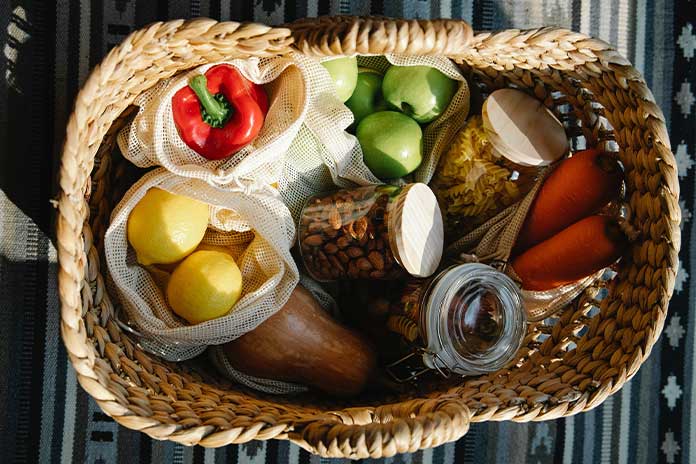Dietary fiber is a real all-rounder: it keeps you full for a long time, helps you lose weight, and stimulates digestion. We’ll show you which foods are particularly rich in fiber.
Ballast doesn’t bode well. However, this does not apply when it comes to high-fiber foods. Because fiber is essential for our body. Strictly speaking, fiber counts as a carbohydrate. However, in contrast to other carbohydrates such as sugar or starch, the organism does not digest fiber but uses it as an energy supplier. In other words: We are full for a long time without consuming a lot of calories.
The German Society for Nutrition recommends that we consume at least 30 grams of fiber with our food every day. Unfortunately, this doesn’t work for most Germans. You are eating far too few high-fiber foods and only reach a maximum of half the recommended intake. At first glance, this doesn’t seem to be a problem because, unlike vitamins and minerals, they are not that well known. But that doesn’t mean they are less important!
Foods rich in fiber keep you feeling full longer and thereby help us eat less. This allows you to lose weight and prevents obesity. In addition, foods rich in fiber have a cholesterol-lowering effect and are suitable for intestinal flora and digestion as a whole. They also play an essential role in preventing colon cancer.
Table of Contents
Two Types Of Fiber
There are two different types of fiber: water-soluble and water-insoluble fiber! Water-soluble fiber (pectins, etc.) can, among other things, help lower cholesterol and blood sugar levels. These can be found in oatmeal, nuts, beans, lentils, apples, and blueberries.
Water-insoluble fiber (cellulose) promotes digestion and prevents constipation, among other things. The water-insoluble fiber can be found in whole grain bread, legumes, carrots, cucumbers, and tomatoes, among other things.
Also Read: Lose Weight With Oatmeal: This Is How It Works!
High Fiber Diet In Everyday Life
But how do you manage to eat 30 grams of fiber and more every day? It’s not that easy. But there are a lot of fiber-rich foods that taste good and most of which you eat regularly.
You should eat five servings of fruit and vegetables a day. Cut an apple into the muesli in the morning, eat a few berries in the office and make sure to always eat a large portion of vegetables or salad with your warm meal. Incidentally, raw food as a snack also tastes delicious. Also tasty: oatmeal, lentil, or bulgur patties.
Also tries to switch to whole grain products because bread and Co. quickly provide a lot of fiber and keep you full for a long time. Good to know: Just because there are many grains in bread, it is far from whole-grain bread. Most bread is colored dark with malt sugar but still contains regular white flour. Pay attention to the list of ingredients or ask specifically in the bakery for bread made from wholemeal flour. It is also available finely ground without grains.
Fiber Suppliers: Flaxseed & Co.
Flax seeds, poppy seeds, or even wheat bran are real fiber bombs. For example, 100 grams of wheat bran contains up to 40 grams of fiber. However, we usually only eat small amounts of these foods. More would also be a bit much for our digestion. And in the case of flax and poppy seeds, the fat content is also relatively high. Our tip: sprinkle a tablespoon of flaxseed or wheat bran over your muesli or salad.
- 100 g wheat bran: 42 g fiber
- 100 g flaxseed: 22 g fiber
- 100 g poppy seed: 22 g fiber
- 100 g pumpkin seeds: 18 g fiber
- 100 g sesame: 12 g fiber
Full Of Fiber: Whole Grain Products
Whole grains, whether in pasta, rice or bread, are always better when it comes to higher fiber content. More fiber keeps you full longer, and the processing of the entire grain also ensures that whole grains taste more aromatic.
Whole grain bread is the perfect source of fiber because it contains up to 9 g of fiber per 100 g. With two 50 g slices, you have already covered a third of your daily requirement. Light-colored bread made from white flour, including toast or pretzels, on the other hand, only contains a maximum of 3 g of fiber per 100 g. It is similar to pasta: 100 g wholemeal noodles contain 8.8 g fiber. The classic light pasta made from wheat flour, on the other hand, only weighs 3.4 g.
- 100 g rye crispbread: 14.8 g fiber
- 100 g pumpernickel: 9.3 g fiber
- 100 g wholemeal rye bread: 8.1 g fiber
- 100 g whole wheat bread: 7.5 g fiber
- 100 g brown
- bread: 6.5 g fiber 100 g mixed wheat bread: 4.6 g fiber
Tip: Have you ever tried protein bread? With 20 g of fiber per 100 g, it is an excellent source of energy.
Also Read: The Mayo Diet: How To Lose Weight With Egg & Grapefruit
High Fiber Food: Dried Fruit
Do you have digestive problems? Then use prunes and other dried fruits because dried fruits are also good sources of fiber and get the intestines going.
But be careful: too much of a good thing quickly leads to the opposite. Dried fruit is also relatively high in calories and contains lots of sugar.
- 100 g dried figs: 12.9 g fiber
- 100 g dried goji berries: 11 g fiber
- 100 g prunes: 9 g fiber
- 100 g baked fruit: 9 g fiber
- 100 g dried dates: 8.7 g fiber
- 100 g dried banana: 7 g fiber
- 100 g raisins: 5.2 g fiber
Vitamin Bombs In Mini Format: Berries
Small, cute, and a great source of fiber! Whether raspberries, blackberries, blueberries, or currants – you can cover part of your daily fiber requirement with these vitamin-rich fruits.
- 100 g black currants: 6.8 g fiber
- 100 g blueberries: 4.9 g fiber
- 100 g raspberries: 4.7 g fiber
- 100 g red currants: 3.5 g fiber
- 100 g blackberries: 3.2 g fiber
By the way: Also the other types of fruit such as apple and Co. are impressive. On average, 100 g has a fiber content of 2 g.
Protein-Rich Sources Of Fiber: Legumes
Legumes, which are better known as vegetable protein sources, are also filling and are excellent sources of fiber—preferably dried goods. Canned foods usually contain significantly less fiber.
- 100 g chickpeas: 21.4 g fiber
- 100 g white beans: 17 g fiber
- 100 g peas: 16.6 g fiber
- 100 g kidney beans: 15.7 g fiber
- 100 g lentils: 10.6 g fiber
Also Read: Food Table: How Many Calories Do Vegetables Have?
High Fiber Snacks: Nuts
Nuts are small all-rounders. They contain good fatty acids, essential minerals, valuable protein, and a lot of fiber.
When snacking, don’t forget: nuts contain plenty of fat, so you should only eat them in moderation.
- 100 g almonds: 15.2 g fiber
- 100 g peanuts (roasted): 11.4 g fiber
- 100 g macadamia nuts: 11 g fiber
- 100 g pistachios: 10.6 g fiber
- 100 g hazelnuts: 8.2 g fiber
- 100 g walnuts: 6 g of fiber
Always Good – Vegetables
Vegetables, in general, are excellent sources of fiber. But above all, the various cabbage vegetables such as Brussels sprouts, broccoli, cauliflower, or white cabbage. But carrots, parsnips, or peppers don’t have to hide either; they also provide around 3 g of fiber per 100 g.
- 100 g black salsify: 18.3 g fiber
- 100 g artichoke: 10.8 g fiber
- 100 g frozen peas: 5.4 g fiber
- 100 g parsnip: 4.5 g fiber
- 100 g Brussels sprouts: 4.4 g fiber
- 100 g kale: 4.2 g fiber
- 100 g fennel: 3.3 g fiber
- 100 g broccoli: 3 g fiber
Great Way To Start The Day With Oatmeal
The oatmeal should not be missing from the high-fiber foods. Regardless of whether you opt for the tender melted flakes or the hearty version for muesli, oat flakes have around 5 g of fiber per 100 g.
Trend Food: Avocado & Co.
Do you fancy guacamole? Go ahead! Because the essential ingredient avocado is also an excellent source of fiber. 100 g equals 6.3 g fiber – but be careful. The avocado also provides a lot of fat.
High fiber superfood:
- 100 g chanterelles (dried): 58 g fiber
- 100 g chia seeds: 34 g fiber
- 100 g quinoa: 6.86 g fiber
Also Read: Apple-Cinnamon Energy Balls With Dates


